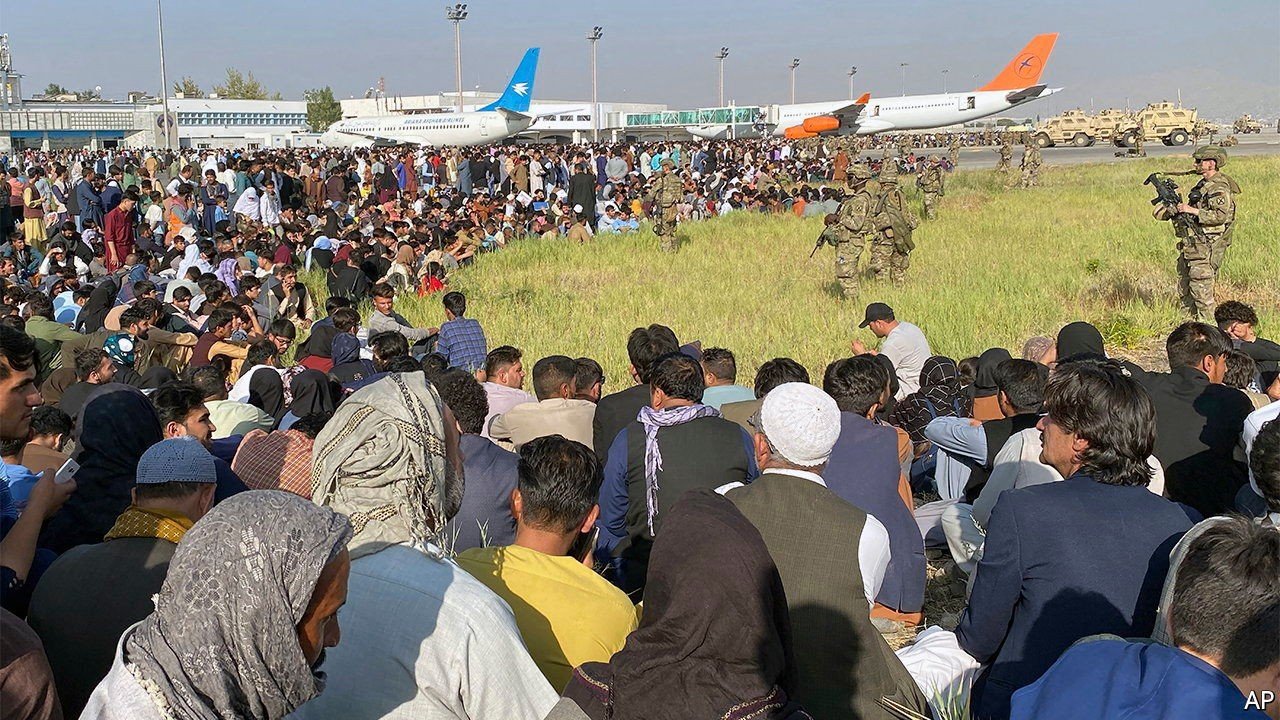WHEN THE evacuation of Saigon began in March 1975, fixed-wing flights were quickly abandoned. Keeping runways open under artillery fire was too difficult. Instead, the American army used helicopters to bring people from all over the South Vietnamese capital to aircraft-carriers in the South China Sea. In landlocked Kabul, the American government does not have that option as it tries to evacuate its own citizens and Afghans who have worked for the United States. And so the scenes beamed all over the world from the city’s airport on August 15th and 16th were not of choppers carrying people to safety, but of an Apache attack helicopter hovering low over the runway to chase off a crowd of desperate Afghans so that planes could take off. The image that people will remember will be that of an air force transport plane taking off with desperate Afghans clinging to its undercarriage, from which they fell to their deaths.
The chaos was predictable. For weeks, flights out of Kabul had been packed with foreigners and those Afghans lucky enough to have passports, visas and money. When the city fell to the Taliban, less than 24 hours after President Ashraf Ghani visited the edge of the capital to inspect its defences, it was inevitable that people would try to flee. The airport is now the only part of Kabul not held by the militants. Instead, it is defended by several thousand American and other foreign troops, many flown in specifically for the evacuation. The Americans have taken over air-traffic control, and their Boeing C-17 transport planes have been leaving packed tightly with refugees. One was reported by Defence One, a website, to have landed in Qatar with 640 passengers, a near record. In one case, the dead body of an Afghan was found in the landing gear of a C-17. A picture showed families crammed into every available space of the cargo bay.
Over the coming weeks, the evacuation could lift away tens of thousands of people. The Pentagon has said that at least 22,000 Afghans who qualify for “special immigrant visas” (SIVs) will be airlifted out, at a rate of 5,000 per day. Germany’s chancellor, Angela Merkel, told her Christian Democratic Union (CDU) party that 10,000 will be admitted. Britain has said 2,700, including 900 Britons and 1,600 Afghans, will be taken to the United Kingdom. How exactly this will work is unclear. Britain’s defence secretary, Ben Wallace, told a radio show that the government had set a deadline of August 31st to finish its evacuation. But as he noted, choking with emotion, “some people won’t get back.”
The last-minute panic to rescue interpreters and others who have worked for foreign armies could have been avoided. America’s SIV programme has been in existence since 2009. Yet it has been taking years to issue visas to former workers. By June 16,000 Afghan workers and their families had been resettled under the programme, but 18,000 applications were still waiting to be processed. In Britain the government by June had resettled only around 1,300 interpreters and their families. It changed its mind on whether Afghans employed indirectly through contractors ought to qualify as late as August 3rd. The rush now is making up for lost time.
The Taliban, for their part, insist the scramble to leave is unnecessary. They have said they have “no plans to take revenge on anyone”, and have promised a “general amnesty” to government employees and asked them to come back to work. Foreign diplomats have been told that they can stay. The UN has continued to work in many parts of the country. Afghan journalists working for TOLONews, a TV channel, have continued broadcasting; female presenters have even interviewed Taliban officials live on air. But though they have not hindered the evacuation flights, Taliban soldiers are reported to be checking people trying to get into the airport, and preventing many from leaving the country. Thousands of Afghans who might be accepted to fly remain in hiding, wondering if they will be able to escape.
What happens next? Over the past four decades of conflict, millions of Afghans have been displaced within the country’s borders and then spilled into neighbouring countries. The UN counts 2.5m registered refugees, or roughly 6% of the country’s population. Of these, an estimated 780,000 Afghan refugees were in Iran, but the UN thinks a further 2m unregistered Afghans are also there. Another 1.4m registered Afghans have taken long-term shelter in Pakistan. Those are among the largest refugee populations anywhere. Efforts to repatriate some of those people are likely to be stalled, and their numbers will probably swell. Iran is bracing itself for a new influx of Shia Muslims fleeing the anti-Shia Taliban (though it has supported them in their fight against America). It is setting up camps in three provinces along its eastern border.
Many may try to go farther. Even as they evacuate their citizens and local friends, politicians in rich countries are already terrified of a bigger emerging refugee crisis. As many as half a million Afghans may already be in Turkey. Even if fighting does not break out again, many more could flee if the Taliban begin to impose their brutal version of sharia in Afghan cities or if humanitarian aid collapses. As recently as August 5th, ministers from six European countries signed a letter supporting the continued deportation of failed Afghan asylum-seekers (many have halted the practice). Emmanuel Macron, the president of France, has promised to crack down on people-smugglers, saying that “we must anticipate and protect ourselves against significant irregular migratory flows”. Armin Laschet, the CDU’s candidate to succeed Mrs Merkel after next month’s German election, has said, “We should not send the signal that Germany can take in everyone in need.” German politicians are worried about a repeat of 2015, when more than 1m Syrian refugees arrived. Some Europeans, notably Mrs Merkel, welcomed them, but a nativist backlash soon followed.
Boris Johnson, Britain’s prime minister, called on countries not to “prematurely recognise” the militants. But for now, tens of thousands of Afghans who worked with international forces, as well as their families, have been abandoned. Millions more face an uncertain future. They will be hoping that the Taliban’s promises mean something, but fearing the worst.
Source: Economist



